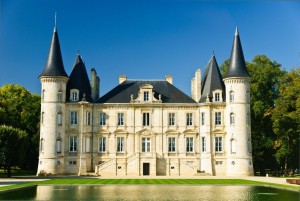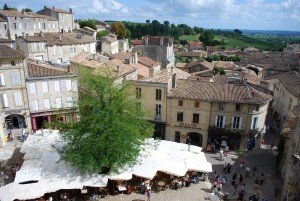For many wine lovers, including ourselves, our interest in wine started with Bordeaux reds. Of course, we hadn’t tasted the greatest of the great Bordeaux chateaux when we were younger; maybe it was Mouton Cadet that first caught our attention and our taste buds. From then on, as we were able to drink better wines, we thought of visiting Bordeaux as the summa of wine tasting experience.
And in many ways, it is. But in a few ways, it isn’t.
For one thing, the wine growing areas around the city of Bordeaux cover a lot of ground and produce rather different grapes and styles of wine. In a gross over-generalization, the vignerons of Medoc north of Bordeaux and Graves to the south make wines heavy in Cabernet Sauvignon; St. Emilion and its satellites to the east favor Merlot; in Pomerol it’s Cabernet Franc; and in the Sauternes-Barsac area they make sweet wines from Semillon. So you don’t exactly go to Bordeaux, you go around it.
The first thing a visitor needs to know is that, as Dorothy might have put it if she were a wine afficianado, “We’re not in California anymore”. You don’t just drive up to a winery, enter the tasting room and ask for a few pours. You need, with a few exceptions, to have appointments. While you can write well in advance and make them yourself, many only deal with the trade. That means you are either a winemaker yourself or otherwise in the wine business. “Otherwise” for these purposes often means tour organizers and brokers. So you wind up paying someone to be an intermediary just to get you in.
Some visits are in groups; others are one-on-one with a guide who will almost always speak English. Anticipate a tour and a tasting, each visit lasting 90 minutes to two hours. The better the wine, the snobbier the visit. And they generally have only one or two wines, so there is less to taste at the end of the tour.
For the most part, the villages aren’t particularly either. The port at Paulliac is a good place to eat oysters right off the boat and Margaux has a few nice bistros, but save your dining experiences for the city of Bordeaux.
That all sounds pretty negative, but there are many more positives that outweigh the foregoing. For one thing, especially in the Medoc, you are visiting real French chateaux. They are gorgeous to behold and to be in; you never know when you might see some nobleman out with the hounds, as actually happened to us in Barton-Léoville. Just driving up the main road, the D2, is to behold castles that seem to come out of fairy tales. Unlike many other vineyard areas, the Medoc is flatland, so the castles you pass more than make up for the lack of rolling hillsides.
Chateau Pichon Baron (Photo courtesy of Wikipedia)
The big, big exception is St. Emilion. It is a medieval town around which wine has been produced for millennia. You can see Roman ruins in the vineyards. Walking through the town, you’ll find enticing restaurants and outdoor cafes. There are bakeries selling the local delicacy called canelés, which are small, rich cakes flavored with rum, vanilla and caramel. And in town and on the outskirts, there are tasting rooms for wineries, where you don’t need appointments. (To be honest, these are not the great ones you came to Bordeaux to visit. Even in this region you need appointments for the big names. But we have found a few that offer very creditable wine.)
St. Emilion (Photo courtesy of Wikipedia)
Perhaps the best reason to go wine tasting in Bordeaux is the effect of the experience. Once having seen the endless vineyards, seen the chateaux, tasted the wines where they’re made, you’ll never open a bottle of Bordeaux wine with the same feeling ever again. You’ve been there, seen it, smelled the grape-sweet air (and maybe stolen grape or two if you go in autumn) and the wine will have an impact on you that you’ll carry with you forever.

